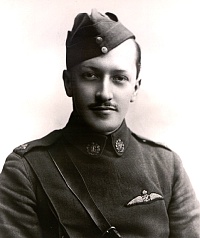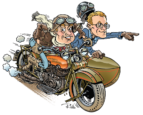I was chatting to a bloke at work the other day and he dug out some interesting information about this ‘Barnstormer’. Further research on the good old internet brought back some interesting information. Ive tried to tie it together in an informative way from various sources. I hope you enjoy this little spot of history.
 It is not generally known that the first man to be awarded the Victoria Cross for gallantry whilst engaged on air operations was of Maori descent. His father, Edward Moorhouse, was English, his mother, Mary Ann Rhodes, was Maori.
It is not generally known that the first man to be awarded the Victoria Cross for gallantry whilst engaged on air operations was of Maori descent. His father, Edward Moorhouse, was English, his mother, Mary Ann Rhodes, was Maori.
Edward and Mary Ann left NZ shortly after their marriage and moved to England, where they settled and raised 4 children. William Moorhouse, the second child was born in London in 1887.
His father tried to interest him in horses and hunting but he hated riding. As a small boy Will became mad about machines of all kinds though he was particularly keen on steam engines and locomotive sets purchased from the Basset-Lowke factory in Northampton. He was a natural mechanic but never shone at school; he left Harrow needing to attend a crammer before going up to Cambridge University where he never quite fitted in. Will had begun his craze for speed on motorcycles but then he and his student friends raced cars on the open road and he became expert at sliding and skid braking: he could skid right into his garage judging it to a matter of inches. He said his time at Cambridge was completely wasted and he wished he had gone straight from Harrow into the engineering shops.
The young William came to New Zealand about 1906 and was given a full ceremonial powhiri.
Reading the New Zealand National archives, there are two articles posted on William Moorehouse and the boy who was tragically killed in the motorcycle accident. This occurred on 22 March 1907 on “New Brighton Beach” in Christchurch New Zealand., while William Moorehouse (aged 19yrs) was testing a motorcycle that had been prepared by a local cycle engineer named Ernest James Ritchie. This Saturday event organised by the Christchurch Cycle Club had been encouraged by the New Brighton municipal authorities and the police had never made objections.
While travelling along the waters edge towards the Waimakariri river at a speed between 60 and 70 miles an hour, an eight year old boy named Frederick Kenneth Gourlay ran across his path and was struck by the motorcycle despite valiant efforts by Moorehouse to bring the bike to a stop or avoid the lad. The boy suffered three broken ribs, a splintered knee and was described as “generally smashed about” when picked up by a spectator. Despite the injuries sustained he lingered on until 8pm that evening.
At the trial where Moorehouse was charged with manslaughter, the presiding judge V.E.Day(SM) said that he would have to commit the accused for trial as a Prima Facie case had been established, and it was his duty to send the accused to a higher tribunal. The accused pleaded not guilty and was committed to the Supreme Court for trial. Bail of 200 Pounds was again allowed and a Surety of 100 Pounds. It is unclear of the outcome of the trial but research suggests that the charges were dropped.
He returned to England in 1907/08. A motorbike fanatic, he raced in the Monte Carlo grand prix before turning his attention to planes, learning to fly at Huntingdon where he teamed up with James Radley, another pioneer aviator. Together they built the Radley-Moorhouse monoplane which resembled the familiar Bleriot type. In this aircraft Will gained considerable experience and became one of the top cross-country pilots of his time. In 1910 he and Radley took a Gnome engined Bleriot barnstorming across the USA to compete for money and fame in the newly popular aero-meetings. They ended up in San Francisco winning the £1,000 Harbour Prize and where Will was the first to fly through the Golden Gate.
In 1911 he came 2nd in the Aerial Derby race around London. He also made the first cargo flight, carrying Barrats boots from Northampton to Hendon. At about this time it is thought he demonstrated the first tail slides and possibly even a loop. He knew many of the early aviators including the Wright Brothers, Graham Gilmour, Gustave Hamel, Col Cody, Claude Graham-White and of course Bleriot
In 1914, in order to inherit his grandfather’s estate, Moorhouse legally adopted the additional surname of Rhodes. With the outbreak of war in 1914, William Rhodes Moorhouse joined the Royal Flying Corps. In March 1915, he was posted to No.2 Squadron R.F.C. based at Merville, France.
In February 1915 he delivered a Parasol Bleriot No 576 to St. Omer and in March such was the need for pilots that he flew out a BE2c No 1657 and joined No 2 Squadron RFC at Merville commanded by Major T I Webb-Bowen. His flight commander was Maurice Blake. Will started operational flying immediately usually flying BE2a No 492 spending the rest of March and most of April doing recce patrols, artillery spotting and photography, frequently recording in his log the incidence of Archie. Ivor Lloyd, recently out of Sandhurst, was regularly his observer and described how they chased enemy aircraft getting so close they could fire their revolvers at the pilots. Lloyd told his family later how in just two months with the squadron ¦he became the life and soul of everything connected with its work and other escapades indulged in by the less serious members of the community. On several sorties later in April his observer was Sholto Douglas, later Air Vice-Marshal in WW2, who was becoming an expert on mounting aerial cameras. After a month in action the Wing Commander, Lt Col Trenchard, recommended Will for promotion.
The 2nd Battle of Ypres had now started and German reinforcements were routed through the railway junction at Courtrai 35 miles beyond the front line. When Trenchard assigned this target to be bombed by No 2 squadron Will took on the task. In his last letter to Linda, his wife, only to be read upon his death, he described how he would have to carry out the attack very low to ensure hitting the target ¦I am off on a trip from which I dont expect to return but which I hope will shorten the war a bit. I shall probably be blown up by my own bomb or, if not, killed by rifle fire. He also left a letter addressed to his 2 month old son William Sonny, full of good advice for his son to read on his 21st birthday.
BE2a No 492 was being repaired from shrapnel damage so he selected BE2b No 687, a good climber, and he took off solo at 3.05pm April 26th carrying a 100lb bomb. On reaching Courtrai he ignored Maurice Blakes advice to bomb from altitude and flew down to below 300ft through a hail of machine gunfire from a church tower and from hundreds of rifles. A shell drove the seat into his left thigh also tearing part of it away. At the same time a piece of shrapnel took off three fingers from his right hand: so to release the bomb he had to let go of the stick and lean right over to activate the mechanism with his left hand. The explosion of his bomb then very nearly sent the aeroplane out of control. His left leg was now useless so he only had his left hand and right leg to fly the machine, added to which the seat was so shattered that it sagged forward into the controls.
At this point he could have landed immediately and saved his life but he judged it more important to return and report the success of his mission and in any case he was determined not to let the Germans have his machine. He was so faint now that he decided to fly very low to keep up speed to re-cross the lines as quickly as possible. Probably while he was crossing the Ypres battlefield he was hit by a bullet which ripped through his abdomen and came to rest just under the skin over the ribs of his left side: this proved to be the fatal wound.
In his diary Maurice Blake described Wills arrival at Merville ¦about 4.12pm saw an aeroplane flying very low on other side of river, when it turned to land machine was only 30ft high. It was Moorhouse and he switched on engine and cleared hedge on other bank and made perfect landing on top ground. Webb-Bowen and I went to machine and we found poor old Moorhouse was badly hit. Sent for stretcher and cut anti-drift wires. He said he felt as if his stomach was shot out of him. Before he died the next afternoon he said to Blake Its strange dying Blake old boy – unlike anything one has ever done before, like ones first solo flight.
After hearing he had earned an immediate DSO he was awarded posthumously the first Victoria Cross ever won in the air. This was Gazetted 23rd May 1915. In making the award the authorities had no knowledge of his letter foretelling so exactly what he was to face and little idea of the professionalism and great experience he drew upon or that the Nation had lost a pilot and engineer who could have in years to come contributed so much more to aviation than this suicidal exploit.
Exceptionally and at his own request his body was allowed back to England and he was buried in specially consecrated ground on top of a hill overlooking Parnham House were he and Linda had planned to build a cottage.
POSTSCRIPT: Wills only son, Flt Lt Willie Rhodes-Moorhouse DFC, gained his pilots licence aged only sixteen having to bicycle from Eton College to Heston Aerodrome to fly as often as he could. In 1937, after hundreds of hours of private flying, he joined 601 Squadron AAF. He also ski-jumped for England in the winter Olympics. In November 1939 he took part in the first fighter/bomber attack of the war flying a Blenheim on the Borkum Raid. Then in January 1940 601 converted to Hurricanes and during the German advance to Dunkirk was briefly based at Merville. Flying from Tangmere he was a Hurricane ace by the time he was awarded the DFC in August. Flying from Hornchurch on the 6th September, he was shot down and killed over Kent along with his wingman Carl Davis, another pre-war 601 pilot. They were probably bounced by Me109s. The very next day the exhausted and much depleted Squadron moved from 11 Group and the front line to Exeter. The Merlin engine and other remains of his Hurricane are displayed at the Battle of Britain Museum, Hawkinge. His ashes were scattered over the grave of his father.
“They shall grow not old, as we that are left grow old:
Age shall not weary them, nor the years condemn.
At the going down of the sun and in the morning
We will remember them”
Fourth stanza of ‘For the Fallen’ by Laurence Binyon (1869 – 1943)
